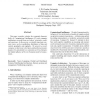413 search results - page 6 / 83 » IT alignment: what have we learned |
BMCBI
2006
13 years 7 months ago
2006
Background: Molecular evolutionary studies of noncoding sequences rely on multiple alignments. Yet how multiple alignment accuracy varies across sequence types, tree topologies, d...
UAI
1998
13 years 9 months ago
1998
The process of diagnosis involves learning about the state of a system from various observations of symptoms or findings about the system. Sophisticated Bayesian (and other) algor...
ITS
2010
Springer
14 years 11 days ago
2010
Springer
The traditional, well established approach to finding out what works in education research is to run a randomized controlled trial (RCT) using a standard pretest and posttest desig...
EUROMICRO
1997
IEEE
13 years 11 months ago
1997
IEEE
This paper considers whether the seemingly disparate fields of Computational Intelligence (CI) and computer architecture can profit from each others’ principles, results and e...
UM
2009
Springer
14 years 2 months ago
2009
Springer
When developing an Adaptive Learning System (ALS), users are generally consulted (if at all) towards the end of the development cycle. This can limit users’ feedback to the chara...

